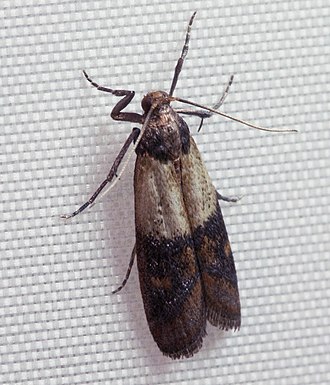Indianmeal moth

The Indianmeal moth (Plodia interpunctella), also spelled as Indian meal moth and Indian-meal moth, is a pyraloid moth of the family Pyralidae. Alternative common names are weevil moth, pantry moth, flour moth or grain moth. The almond moth (Cadra cautella) and the raisin moth (Cadra figulilella) are commonly confused with the Indian-meal moth due to similar food sources and appearance. The species was named after being noted for feeding on Indian-meal or cornmeal and it does not occur natively in India as the aberrant usage of Indian meal moth would suggest. It is also not to be confused with the Mediterranean flour moth (Ephestia kuehniella), another common pest of stored grains.
P. interpunctella larvae (caterpillars) are commonly known as waxworms. It is important to note that they are not the same species as the waxworms often bred as animal feed. Rather, they are a common grain-feeding pest found around the world, consuming cereals, fruits, and similar products. Substantial efforts have been taken in the United States to control the moth’s damage to grain crops.[1]
The larvae of this species have the ability to bite through plastic and cardboard so even sealed containers may be infested.[2] Once found, the moths are difficult to eradicate. The last instar larvae is also able to travel long distances before pupating; so an infestation site may be located far from the nearest pupation site.[3] In addition to food sources, this species can reproduce and pupate on clothing and any source of clothing must be inspected to prevent reinfestation.
Plodia interpunctella is found on every continent in tropical habitats, excluding Antarctica.[4] Within the United States, the moth is most commonly found in Florida, where it thrives in the tropical habitat.[3] The moth lives in a wide range of conditions, making it a persistent pest. It is often found at food storage facilities worldwide, specifically in grain bins or grain storage buildings.[5]
The Indian-meal moth is the only known living species of the genus Plodia. It is closely related to the genera Cadra and Ephestia, which include other pest species like E. kuehniella, also known as the “flour moth”.[6][7]
The species has been described under a number of junior synonyms, which may occasionally still be found in non-entomological sources.[7]
Adults are 8–10 mm in length with 16–20 mm wingspans. The distal two thirds of their forewings are generally reddish brown in color with a copper luster. They can also be bronze or dark gray. The more proximal parts of the wings are yellow-gray or white-gray, with a dark band at the intersection between the proximal and distal regions. The hindwings, in general, are uniformly gray.[9]
The eggs of the Indian-meal moth are white, ovate, and very small. It is difficult to see them with the naked eye. Newly-hatched larvae are equally difficult to see. They are mostly off-white in color, have brown heads, and develop through five to seven larval instars. When these larvae mature, they measure about 12–14 mm long. Larvae also have three sets of legs near the head and five sets of prolegs protruding from the abdomen. The legs help the larvae move over long distances in order to find pupation sites.[9]
